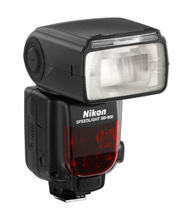Article
Nikon
SB900 First look
2nd July 2008
|

Nikon SB900 |
Nikon announced this week the SB900 speed light. At the moment no instruction manual is
available, so we cannot yet do an in depth study of the flash unit.
What we can do now is to take a first look, and compare information that we
have to hand with the SB800 that we know so well.
This flash unit is similar to the
existing top of the range, the SB800, it has slightly lower power than the
SB800, but can zoom its head over a larger range, and can give different
light patterns to match FX and DX sensors, while the SB800 is really designed
for the DX range. The quoted range that the flash can reach is the same,
presumably brought about by being able to zoom more while the power is
slightly less. From the figures on the specification it appears to cycle
between photos about 20% faster, but this is always dependent on the
batteries and state of charge at the time. The SB800 operates faster by
adding a 5th battery, this has been done away with on the SB900. Its
commander function and working with the creative lighting system appears the
same. Its firmware can be updated via a D3 or D700. If you haven't got one
of these then presumably its not able to be done without sending it away.
|
The SB800 can be used with colour gel filters provided to correct the light,
so for example you can use a filter to change to the same colour as light bulbs,
reset the white balance on the camera, your flash now works with the
available internal light. This means that at a wedding reception the bride and
groom cutting the cake and distant background are both the right colour, rather
than the background having an orange cast. This works but fitting the gels is
not ideal. The SB900 has a filter holder, and is able to detect when a gel is in
use, its colour, and feeds this information to some cameras. (We don't know which
ones). However there are optional water guards that can be purchased for the
D300, D700 and D3, so its these that this lash is most likely to have most
compatibility with.
| The extra zoom is an improvement going out to 17mm and up
to 200mm, the SB800 was from 24mm to 105mm, you then pulled out a wide angle
diffuser to get to 17mm and put on the diffuser dome to get to 14mm. The longer
zoom has no impact, but the wider angle zoom will make it quicker to use when
wider angle lenses are used. |
|
We need an instruction manual before we can fully
define the differences and see the effect. At first sight it has minor
advantages in terms of the wider zoom and filter holder, but for DX users not
enough to want to change if you already have a SB800. For FX users (D3 and D700)
the situation is different they need a wider light spread than the DX users for
the same focal length, and the other flashes in the series may not always give
them this, so a SB900 could be a good upgrade for them. We have a page
explaining the
full
range of Nikon flash units produced a few months back. Flash guide numbers
are explained by
clicking here produced a few months back. Flash guide numbers
are explained by
clicking here
 the guide number are:- the guide number are:-
|
Flash unit |
ISO 100 |
IS0 200 |
|
SB800 |
125/38 |
185/53 |
|
SB900 |
111.5/34 |
157.5/48 |
|